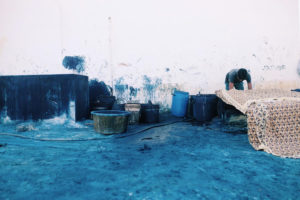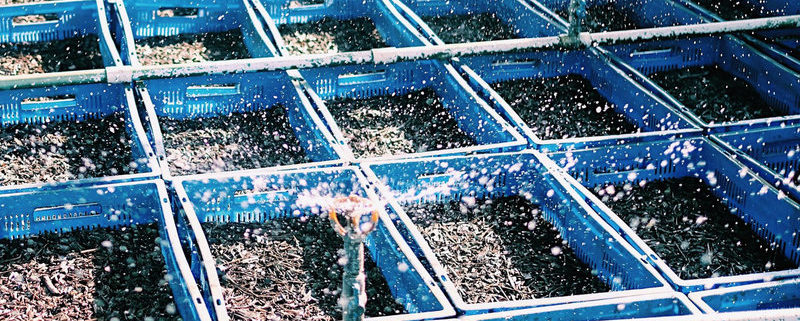Worms Treat Wastewater from Textiles
In the northwest Indian village of Ajrakhpur, 37-year-old Sufiyan Khatri stirs several stinky vats: one of bubbling indigo, another simmering pomegranate skins and a third containing a black, gummy brew of rusty bicycle parts fermenting with sugar cane. The mixtures are used to dye textiles with a traditional block-print method called ajrakh. He is one of more than 50 artisans in the village producing the textiles as a main source of income.

Sufiyan Khatri learned to make the textile dyes from his grandfather, but he likes to experiment with color and design.
And he’s been pleased to have welcomed some new assistants: earthworms. Their job is to deal with toxic materials in the dyes that are not only bad for the environment but also make it impossible to reuse the wastewater for the next round of dyeing. Thousands of the wiggly creatures live inside a water filter — called a « vermifilter. » That’s the term for a treatment system that cleans dye-tainted water. It was installed last May with support from the nongovernmental organization KHAMIR — Kutch Heritage, Art, Music, Information and Resources. The group connects the artisans of the Kutch district with outside resources and markets.
The filter is a few feet from Khatri’s studio. It is constructed out of dozens of bright blue plastic crates packed with organic materials including cotton roots, dirt and all of those earthworms. Sprinklers spray murky blue water from attached tanks into the crates. The water trickles through the dirt. Worms then feed on toxic dyes in the wastewater and excrete « wormcasts » that are not toxic. The water is filtered through the worm poop, the cotton roots and other materials and comes out a pale yellow — and clean enough to reuse in the textile process.
The ability to reuse water is critical for the village, which consumes over 52,000 gallons of water every day to maintain an annual output of over almost 460,000 square feet of hand-printed cloth. Each piece is washed at least three times in community water tanks. And the artisans say they create colors by « playing with water » — adding varying amounts of ingredients like pomegranate skins and then bringing the mixture to a boil.
Hundreds of years ago, Ajrakh artisans had plenty of water to play with. But groundwater in northwest India is increasingly depleted due to overuse, Ajrakhpur’s artisans are concerned about the future of their craft. « If we don’t get water, » Khatri says, « We stop our work. »

Wasseem Abbas dips cloth printed with mud in fermented indigo. After it dries, the cloth will be washed several times and if the water used has a high iron content, dark spots will appear on the fabric.
Signs that something is amiss are already visible on Khatri’s textiles. As water levels decrease, minerals in it like iron become more concentrated, which can leave dark spots on prints after the artisans wash them. And there are more serious problems: the release of dyes into the environment is a main source of water pollution. Khatri prides himself on using natural dyes, but many artisans use water tainted by synthetic dyes — and dispose of it in open drains.
Khatri says artisans appreciate that the worms have already cut their water costs. But the output of the filter — about 13,500 gallons per day— is far from what they need to meet a growing demand for their textiles. The Indian government has approved a grant funded by India’s Ministry of Textiles to build a vermifilter in Ajrakhpur three times the size of the current one. It will be completed in the next two years.
Vermifiltration technology was first made available in Chile in the 1990s. The largest systems are in South America, where they are predominantly used for treating industrial wastewater, according to Kevin Jeffery, managing director of Wastewater Wizard Limited. He calls vermifiltration « a revolutionary approach to wastewater treatment. »
However, there are limitations, says professor Ralf Otterpohl, director of the Institute of Wastewater Management and Water Protection at Hamburg University of Technology. One of the biggest challenges is that the worms need warm soil temperatures to thrive. Plus, he adds, this type of technology is most suitable for small-scale production.
That still leaves plenty of opportunity for Transchem Agritech, the enterprising Indian company that installed the vermifilter in Ajrakhpur. The company has vermifilters across India’s dairy, sugar and chemical industries. The one in Ajrakhpur is the first in the handicraft industry, so developing the right environment for the worms — with the right mix of materials so they could help minimize the dyes in the water — required some tinkering.
As Khatri says: « We have to be creative to continue. »




Laisser un commentaire
Rejoindre la discussion?N’hésitez pas à contribuer !